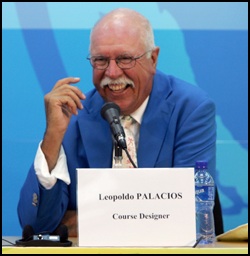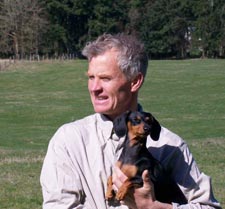By Jackie McFarland
Who better to sit with during the $50,000 Grand Prix of California at Showpark Ranch & Coast Tournament than the course’s illustrious designer? Often named by other designers as a mentor, I was fascinated by the mind behind the man known as Leopoldo Palacios.
 How did you become a course designer? What is your horse history?
How did you become a course designer? What is your horse history?
LP: I come from a horsey family in Venezuela. My father had horses; I rode and competed up to the Grand Prix level. My older brother, Jesus Eduardo Palacios, was a fantastic rider. He won the Grand Prix at the National Horse Show in 1960.
I have worked as a contractor, mostly hotel construction, all my life and used to course design on the side as a hobby. That started in the 1970’s. It got to the point that I would split my time, about twenty-five weeks a year as a contractor and twenty-five weeks as a course designer.
When I retired from construction a decade ago, I followed my passion and started course-designing full time. My first job designing in the United States was in Ocala about 20 years ago. I designed for the Olympics in Sydney nine years ago.
Your course design mentors?
LP: Three influenced me the most – Pamela Carruthers, Dr. Arno Gego and Bert de Nemethy. I was an assistant to all of them. Arno was the course designer at Aachen for 20 years and established the Aachen School of Course Design; I worked with him quite a bit from 1980-85.
How do you determine difficulty for the field?
LP: For me the most important part is to know the riders. They are essentially my customers in every class. I believe that course designers need to tailor make courses for the field we have. Not so easy as to have too many clean, not too hard.
Course designers are like chefs. We take height, distance, scope, time allowed, the way we use the materials, positions of the jumps, shadows, terrain plus a dash of this or that – when we put the various ingredients together successfully we make a great course. Our job is to make it work for different types of horses – a variety of tests for horse and rider using our ingredient options without overdoing it by making too salty or too spicy.
I am happy that here we have three types of horses clean so far today [for the $50,000 Grand Prix of California], – a small, catty horse, Nadia (Will Simpson), Kaskaya (Jill Humphrey) is a medium horse in size and Urian (Guy Thomas) a large horse – all different types, all able to go clean.
How does the course like the one today evolve for you?
LP: I take many steps to create this course. First I research courses I’ve designed in years past to see what questions I’ve asked. Then early in the week I determine where I will place the triple and double combinations for the Grand Prix and I’m careful to save the footing around this area when building other courses. Throughout the week I see who my real customers are – what possibilities I have for designing a course where the best on that day will go clean. After this step I start to decide if these combinations will stand-alone or have related distances leading up to or after them and where they will fall in the course, early or late. Then I begin to connect the combinations to develop the rest of the course. I am careful to choose how the jumps relate, not having too many similar types in succession and choosing different striding in the lines. Put this all together and I’ve produced a track. Riders need to understand the track. The psychology of the rider is so important.
Analyzing the track…
It is key to note here – and one of the most essential lessons – that we analyzed the track, not the course. The technical questions asked aren’t just jumps with height or width, but how the rider approaches the jump, what track will keep them within the time allowed and how they mentally handle the challenges on the track. For this particular course Leopoldo presented a number of mental puzzles including a steady seven to a long one stride, to a long two stride in the triple combination towards the end of the course. Many the rails (and some of the riders) fell due to the above.
LP: I made the ride to the triple combination a bit too difficult for the field. My mistake is that the second element is a bit solid with a gate, which is backing horses off more than I had planned. The riders’ mistakes are happening because they need to steady early in the seven so they are coming forward for the ride through the triple. Too many are riding steady as they jump in.
And your future?
LP: Time passes and I am getting old [laughs] but I work with a wonderful team of course designers around the world – I learn from them and they learn from me. I am designing almost non-stop through The Masters in Spruce Meadows in September.
We would love to follow Leopoldo and his fellow course designers as they trek around the world designing tracks that challenge riders at all levels. What an interesting life they lead, constantly considering how to challenge on course. Thank you Leopoldo!
 During the first week of the Blenheim Spring Series, which was host to final World Cup Qualifier, we took the opportunity to speak with Canadian course designer Peter Holmes.
During the first week of the Blenheim Spring Series, which was host to final World Cup Qualifier, we took the opportunity to speak with Canadian course designer Peter Holmes.